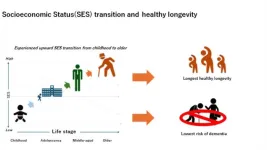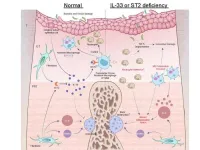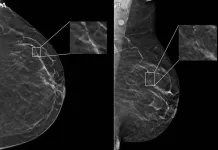(Press-News.org) Sensors enable us to monitor changes in systems of all kinds.
The materials at the heart of those sensors, of course, ultimately determine their end-use application. Devices made of silicon, for example, enable ultrafast processing in computers and phones, but they aren’t pliable enough for use in physiological monitoring.
They also require a lot of energy to produce.
Lehigh University professor Elsa Reichmanis, Carl Robert Anderson Chair in the Department of Chemical and Biomolecular Engineering, recently received a grant from the National Science Foundation for her proposal to identify new materials platforms that could form the basis of effective sensors for applications in areas like physiological, environmental, and Internet of Things monitoring, while increasing the energy efficiency of fabrication processes.
“We’ll be creating the polymers that could be the building blocks of future sensors,” says Reichmanis, who is the lead researcher on the project, which also includes Thomas Gartner, an assistant professor of chemical and biomolecular engineering in the P.C. Rossin College of Engineering and Applied Science. “The systems we’re looking at have the ability to interact with ions and transport ionic charges, and in the right environment, conduct electronic charges.”
Having the ionic charge within the organized polymer network can essentially “dope” the charge of the polymer so that it becomes a semiconductor.
“And then as a semiconductor with very low applied voltages,” she says, “there will be charge transport, which can then lead to an electronic signal readout that can tell you what's happening.”
The network will also be functionalized to interact with various species, she says. Taken together, functionalized material that can act as a semiconductor could be used in a range of applications.
“They could be used in biomedical sensors to react to different bacteria or a virus or changes in metabolites,” she says. “Environmental sensors could be used in atmospheric monitoring to detect various pollutants and where they are, and in what concentrations. And for Internet of Things applications, these sensors could allow workstations to feed information using wireless signaling.”
Specifically, Reichmanis, Gartner and their team will explore what kinds of polymers and functionalities will support organic mixed ion electron conduction, where both ions and electrons get transported. That ability to support the transport of both allows for a better signal-to-noise ratio, which enables the user to determine if something is, indeed, really there. It also allows for devices to operate at low voltage—an especially important characteristic when considering their use on or in the human body.
“We’ll be researching the chemistries involved, but then simultaneously, from a modeling simulation perspective, how are these ions actually interacting with the polymers and their functionalities on a more fundamental level? What is the interaction between ion transport and electron transport?”
Ultimately, she says, the goal is to broaden the choice of building block materials, expand the functionalities that support mixed conduction, and come to a better understanding of what mixed conduction is really about.
“We have the opportunity to develop something within a real area of need,” says Reichmanis, “and because these devices are so wide-ranging, it opens up opportunities for much broader collaborations.”
Related Links
NSF Award Abstract #2408881: Carboxyl-alkyl Functionalization for Sustainable Mixed Conduction Polymers: molecular design and mechanistic insights
Rossin College Faculty Profile: Elsa Reichmanis
Rossin College Faculty Profile: Thomas E. Gartner III
Reichmanis Research Group
Gartner Group @ Lehigh ChBE END
Polymer research aims to expand possibilities in sensor technology
With new NSF funding, Lehigh University research team to develop materials that will support organic mixed ion electron conductors for future use in biomedical, environmental, and Internet of Things sensor applications
2024-05-21
ELSE PRESS RELEASES FROM THIS DATE:
New therapeutic avenues in bone repair
2024-05-21
Birmingham researchers have shown PEPITEM, a naturally occurring peptide (small protein) holds promise as a new therapeutic for osteoporosis and other disorders that feature bone loss, with distinct advantages over existing drugs.
PEPITEM (Peptide Inhibitor of Trans-Endothelial Migration) was first identified in 2015 by University of Birmingham researchers.
The latest research, published today in Cell Reports Medicine, show for the first time that PEPITEM could be used as a novel and early clinical intervention to reverse the impact of age-related musculoskeletal diseases, with ...
Socioeconomic status transition throughout life and risk of dementia
2024-05-21
About The Study: This cohort study of Japanese older adults identified that upward and downward socioeconomic status transitions were associated with risk of dementia and the length of dementia-free periods over the lifespan. The results may be useful to understand the association between social mobility and healthy longevity.
Corresponding Author: To contact the corresponding author, Hiroyasu Iso, Ph.D., email iso@pbhel.med.osaka-u.ac.jp.
To access the embargoed study: Visit our For The Media website at this link https://media.jamanetwork.com/
(doi:10.1001/jamanetworkopen.2024.12303)
Editor’s Note: Please see ...
Climbing the social ladder slows dementia, Japanese study reveals
2024-05-21
Osaka, Japan – Upward social mobility may ward off dementia, according to a new study. Dementia, a collective term for conditions marked by memory loss and diminished cognitive functioning, strains healthcare systems and devastates quality of life for patients and their families. Research thus far has found correlations between socioeconomic status (SES) – Parent’s asset, education level, income, and work status – and susceptibility to dementia, and SES changes throughout a person’s life, known as social mobility, seem to influence this risk; however, scientific ...
Researchers discover hidden step in dinosaur feather evolution
2024-05-21
Scientists discover ‘zoned development’ in dinosaur skin, with zones of reptile-style scales and zones of bird-like skin with feathers
New dinosaur skin fossil found to be composed of silica – the same as glass
Discovery sheds light on evolution from scales to feathers
Palaeontologists at University College Cork (UCC) in Ireland have discovered that some feathered dinosaurs had scaly skin like reptiles today, thus shedding new light on the evolutionary transition from scales to feathers.
The researchers studied a new specimen of the feathered dinosaur Psittacosaurus from the early Cretaceous ...
Studies reveal cell-by-cell changes caused when pig hearts and kidneys are transplanted into humans
2024-05-21
Surgical teams at NYU Langone Health performed the world’s first genetically modified pig kidney transplants into a human body in September and November 2021, and then transplanted two pig hearts in the summer of 2022. These procedures were done in patients declared dead based on neurologic criteria (decedents) and maintained on ventilators with the consent of their families. Demonstrating the field’s progress, NYU Langone in April 2024 transplanted a pig kidney into a living patient.
Now two new analyses, one published online on May 17 in Nature Medicine and the other May ...
SRI earns FDA Orphan Drug Designation for pancreatic cancer
2024-05-21
SRI’s Targeted Antigen Loaded Liposomes (TALL) — a treatment that expands the benefits of immunotherapy such as check-point inhibitors — has been granted Orphan Drug Designation (ODD) for pancreatic ductal adenocarcinoma (PDAC) by the U.S. Federal Drug Administration (FDA).
As a result, SRI’s future strategic partners can gain tax credits for qualified clinical trials and potentially receive market exclusivity for a period of seven years after the drug’s approval, among other benefits.
“FDA's orphan drug designation brings worthy attention to the demonstrated impact of SRI's TALL biotherapeutic for pancreatic cancer,” said Kathlynn Brown, ...
A new gene-editing system tackles complex diseases
2024-05-21
The human genome consists of around 3 billion base pairs and humans are all 99.6% identical in their genetic makeup. That small 0.4% accounts for any difference between one person and another. Specific combinations of mutations in those base pairs hold important clues about the causes of complex health issues, including heart disease and neurodegenerative diseases like schizophrenia.
Current methods to model or correct mutations in live cells are inefficient, especially when multiplexing — installing multiple point mutations simultaneously across the genome. Researchers from the University of California San Diego ...
Tracking down toxic metals from tobacco smoke
2024-05-21
Cigarette smoke has been studied for years, revealing a multitude of contaminants, including toxic metals. But exactly which of those metals can be traced to secondhand or thirdhand smoke? Solving this problem has been a challenge for the research community because many of the metals found in tobacco smoke could also come from industrial or naturally occurring pollutants contaminating indoor and outdoor air.
Now, a recent study by scientists at Lawrence Berkeley National Laboratory (Berkeley Lab) has identified 28 trace metals in tobacco smoke. The findings reported in the journal ...
Clarifying the cellular mechanisms underlying periodontitis with an improved animal model
2024-05-21
TMDU researchers have developed a technique that allows a detailed analysis of periodontitis development over time
Tokyo, Japan – Periodontal disease, represented by periodontitis, is the leading cause of tooth loss and affects close to one in five adults worldwide. In most cases, this condition occurs as a result of an inflammatory response to bacterial infection of the tissue around teeth. As the condition worsens, the gums begin to pull away, exposing teeth roots and bone. Notably, the incidence of periodontitis becomes more prevalent with age and with populations worldwide living ...
Age, race impact AI performance on digital mammograms
2024-05-21
OAK BROOK, Ill. – In a study of nearly 5,000 screening mammograms interpreted by an FDA-approved AI algorithm, patient characteristics such as race and age influenced false positive results. The study’s results were published today in Radiology, a journal of the Radiological Society of North America (RSNA).
“AI has become a resource for radiologists to improve their efficiency and accuracy in reading screening mammograms while mitigating reader burnout,” said Derek L. Nguyen, M.D., assistant professor at Duke University in Durham, North Carolina. ...
LAST 30 PRESS RELEASES:
New technique lights up where drugs go in the body, cell by cell
New study finds movement of fishing fleets can reveal shifts in marine ecosystems
Embargoed: New evidence points to potential treatment for vascular dementia
Study uncovers disrupted brain balance in alcohol dependence
Working in groups can help Republicans and Democrats agree on controversial content moderation online
Structural findings reveal how distinct GPCR ligands create different levels of activation
Anything-goes “anyons” may be at the root of surprising quantum experiments
UC review: Maximizing workplace opportunity for veterans
From generation to complex control: Metasurfaces make perfect vortex beams "within reach"
Thin-film lithium niobate-based detector: recent advances and perspectives
Exploring why some people may tend to persistently make bad choices
How cells balance their protein levels
Nirsevimab vs RSVpreF vaccine for RSV–related hospitalization in newborns
Effectiveness and impact of maternal RSV immunization and nirsevimab on medically attended RSV in US children
AI gives scientists a boost, but at the cost of too many mediocre papers
Next-generation vision model maps tree growth at sub-meter precision
Genes aren’t destiny for inherited blindness, study shows
MIT study: High-fat diets make liver cells more likely to become cancerous
Exposure to multiple fine particulate matter components and incident depression in the US Medicare population
Risk of burdensome health care spending over time in the US
Nirsevimab against hospitalizations and emergency department visits for lower respiratory tract infection in infants
New microfluidics technology enables highly uniform DNA condensate formation
A new strategy for immune tolerance
Super Mario Bros. help fight burnout: New study links classic games to boosted happiness
Deepest gas hydrate cold seep ever discovered in the arctic: International research team unveils Freya Hydrate Mounds at 3,640 m depth.
Integrating light and structure: Smarter mapping for fragile wetland ecosystems
ACA-SIM: A robust way to decode satellite signals over complex waters
Probiotics can restore gut microbiome in breastfed infants
AI could help predict nutrition risks in ICU patients, study finds
Federal EITC has unexpected result, researchers say – it decreases domestic violence
[Press-News.org] Polymer research aims to expand possibilities in sensor technologyWith new NSF funding, Lehigh University research team to develop materials that will support organic mixed ion electron conductors for future use in biomedical, environmental, and Internet of Things sensor applications







